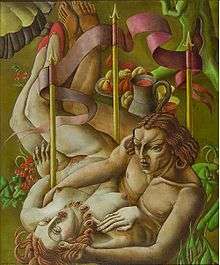Ithell Colquhoun
| Ithell Colquhoun | |
|---|---|
 Song of Songs 1933 | |
| Born |
Margaret Ithell Colquhoun October 9, 1906 Shillong, Eastern Bengal and Assam, British India |
| Died |
April 11, 1988 (aged 81) --> Cornwall |
| Nationality | British |
| Known for | Surrealist painter and author |
Ithell Colquhoun (9 October 1906 – 11 April 1988) was a British Surrealist painter and author. She was born in Shillong, Eastern Bengal and Assam, British India. From the 1930s to her death, her work was exhibited widely in Britain and Germany.
Biography

Margaret Ithell Colquhoun was born in Shillong, Eastern Bengal and Assam, British India. Her parents were Henry Colquhoun, an assistant to the ambassador in Manipur, and his wife Georgia. Colquhoun was educated in Rodwell, near Weymouth, Dorset before attending Cheltenham Ladies' College. There she studied topics such as the cabbala and the occult.[1]
Colquhoun studied for a period at the Slade School of Art in London, under Henry Tonks and Randolph Schwabe, before travelling to France in 1931. It was in Paris that she discovered surrealism and was especially influenced by the works of Salvador Dalí. Another influence on Colquhoun was the psychomorphological works of Roberto Matta and Onslow Ford. Her first one-woman exhibition of works was at Cheltenham Art Gallery in 1936. Soon after, she joined the political group, Artists' International Association. By 1939, Colquhoun had joined the English Surrealist Group and in June she and Rowland Penrose showed their works in a joint exhibition at Mayor Gallery. There they created a scandal by asking a vagrant to sit in the window.[1]
In 1940, E. L. T. Mesens, head of the English Surrealist Group, expelled her from the group for carrying on with occult research. She became a member of the Druidic Order and the Order of the Stella Matutina, both occult groups. After the 1950s, she was regarded as a 'fantamagiste', an unorthodox surrealist who focus on the occult.[1]
Colquhoun lived with Antonio Romanov del Renzio in London during World War II, marrying him in July 1943 and divorcing him a few years later. From 1946, Colquhoun kept a studio near Penzance, Cornwall, while living in London. She finally moved to Cornwall in 1957, where she lived until her death on 11 April 1988.[1]
Works
"In her paintings, drawings, constructions, prose, and poetry, the organic and the inorganic, the masculine and the feminine, the earthly and the spiritual join in often strongly erotic, if not outspokenly sexual, encounters, in an attempt to fuse with the forces of the beyond."
Michel Remy, Oxford Dictionary of National Biography[1]
Colquhoun's early works included a series of enlarged images of flora, occupying the full canvas and painted almost photographically. By the late 1930s, she had painted two significant pieces; Scylla in 1938, whose joined rocks in the water creates the impression of a "feminine opening" whilst also showing phallic imagery, and Rivières tièdes which shows liquids flowing from a Mediterranean church.[1]
In the 1940s, Colquhoun's works were experiments to explore consciousness and the subconscious. She did this by using recognised methods such as decalcomania, fumage, frottage and collage. Colquhoun went further, developing new techniques such as superautomatism, stillomanay, parsemage, and entoptic graphomania writing about them in her article The mantic stain.[1]
Three works which stand out during the 1940s are The Pine Family, which deals with dismemberment and castration, A Visitation which shows a flat heart shape with multicoloured beams of light and Dreaming Leaps, a homage to Sonia Araquistain.[1] Colquhoun did not define herself as a Surrealist artist, as she only too part in a single Surrealist exhibit. Instead she considered herself "independent"[2]
Bibliography
- Salvo for Russia, 1942 (contributor)
- The Fortune Anthology, 1942 (contributor)
- The crying of the wind : Ireland, 1955
- Living Stones Cornwall, 1957
- Goose of Hermogenes, 1961
- Grimoire Of The Entangled Thicket (1973)
- Sword Of Wisdom - MacGregor Mathers and the Golden Dawn, 1975
- The Rosie Crucian Secrets: Their Excellent Method of Making Medicines of Metals Also Their Lawes and Mysteries, 1985 (provides introduction)
- The Magical Writings of Ithell Colquhoun, 2007 (edited by Steve Nichols)
- Ithell Colquhoun: Magician Born of Nature, 2009/2011 (by Richard Shillitoe)
References
- 1 2 3 4 5 6 7 8 Remmy, Michel (2009). "Colquhoun, (Margaret) Ithell (1906–1988), painter and poet". Oxford Dictionary of National Biography (online ed.). Oxford University Press. doi:10.1093/ref:odnb/64737. (Subscription or UK public library membership required.)
- ↑ Gaze, Delia (1997). Dictionary of women artists. Taylor & Francis. pp. 412–413. ISBN 9781884964213.